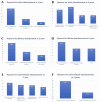Clinician prescription of lipid-lowering drugs and achievement of treatment goals in patients with newly diagnosed type 2 diabetes mellitus
- PMID: 33568360
- PMCID: PMC7878159
- DOI: 10.1136/bmjdrc-2020-001891
Clinician prescription of lipid-lowering drugs and achievement of treatment goals in patients with newly diagnosed type 2 diabetes mellitus
Abstract
Introduction: Lipid control is essential in type 2 diabetes mellitus (T2DM). The aim of this study is to investigate factors associated with lipid therapy adherence and achievement of goals in real-life setting among patients with recently diagnosed T2DM.
Research design and methods: This is a longitudinal analysis in a center of comprehensive care for patients with diabetes. We include patients with T2DM, <5 years of diagnosis, without disabling complications (eg, amputation, myocardial infarct, stroke, proliferative retinopathy, glomerular filtration rate <60 mL/min/m2) and completed 2-year follow-up. The comprehensive diabetes care model includes 9 interventions in 4 initial visits and annual evaluations. Endocrinologists follow the clinic's guideline and adapt therapy to reach risk-based treatment goal. The main outcome measures were the proportion of patients meeting low-density lipoprotein cholesterol (c-LDL) (<100 mg/dL) and triglycerides (<150 mg/dL) and proportion of patients taking statin, fibrate or combination at baseline, 3 months and annual evaluations.
Results: We included 288 consecutive patients (54±9 years, 53.8% women), time since T2DM diagnosis 1 (0-5) year. Baseline, 10.8% patients were receiving statin therapy (46.5% moderate-intensity therapy and 4.6% high-intensity therapy), 8.3% fibrates and 4.2% combined treatment. The proportion of patients with combined treatment increased to 41.6% at 3 months, decreased to 20.8% at 1 year and increased to 38.9% at 2 years of evaluation. Patients receiving treatment met LDL and triglycerides goals at 3 months (17% vs 59.7%, relative ratio (RR)=0.89, 95% CI 0.71 to 1.12), at 1 year (17% vs 26.7%, RR=0.62, 95% CI 0.41 to 0.95) and at 2 years (17% vs 29.9%, RR=0.63, 95% CI 0.43 to 0.93). Main reasons for medication suspension: patient considered treatment was not important (37.5%) and other physician suspended treatment (31.3%).
Conclusion: 88.2% of patients with T2DM required lipid-lowering drugs. Education for patients and physicians is critical to achieve and maintain diabetes goals.
Trial registration number: NCT02836808.
Keywords: lipids; treatment outcome.
© Author(s) (or their employer(s)) 2021. Re-use permitted under CC BY-NC. No commercial re-use. See rights and permissions. Published by BMJ.
Conflict of interest statement
Competing interests: None declared.
Figures


Similar articles
-
Quality improvement strategies for diabetes care: Effects on outcomes for adults living with diabetes.Cochrane Database Syst Rev. 2023 May 31;5(5):CD014513. doi: 10.1002/14651858.CD014513. Cochrane Database Syst Rev. 2023. PMID: 37254718 Free PMC article.
-
Preexisting Diabetes and Pregnancy: An Endocrine Society and European Society of Endocrinology Joint Clinical Practice Guideline.Eur J Endocrinol. 2025 Jun 30;193(1):G1-G48. doi: 10.1093/ejendo/lvaf116. Eur J Endocrinol. 2025. PMID: 40652450
-
Disease Awareness in Patients With Type 2 Diabetes: Analysis of Baseline Data From the SMART-Finder Observational Study.JMIR Form Res. 2025 Feb 18;9:e60246. doi: 10.2196/60246. JMIR Form Res. 2025. PMID: 39964736 Free PMC article.
-
Intensive glucose control versus conventional glucose control for type 1 diabetes mellitus.Cochrane Database Syst Rev. 2014 Feb 14;2014(2):CD009122. doi: 10.1002/14651858.CD009122.pub2. Cochrane Database Syst Rev. 2014. PMID: 24526393 Free PMC article.
-
Diet, physical activity or both for prevention or delay of type 2 diabetes mellitus and its associated complications in people at increased risk of developing type 2 diabetes mellitus.Cochrane Database Syst Rev. 2017 Dec 4;12(12):CD003054. doi: 10.1002/14651858.CD003054.pub4. Cochrane Database Syst Rev. 2017. PMID: 29205264 Free PMC article.
Cited by
-
Type 2 Diabetes (T2DM) and Parkinson's Disease (PD): a Mechanistic Approach.Mol Neurobiol. 2023 Aug;60(8):4547-4573. doi: 10.1007/s12035-023-03359-y. Epub 2023 Apr 28. Mol Neurobiol. 2023. PMID: 37118323 Free PMC article. Review.
-
Eligibility for icosapent ethyl in a French population of coronary outpatients with type 2 diabetes.Arch Med Sci. 2023 Oct 24;19(6):1901-1903. doi: 10.5114/aoms/173511. eCollection 2023. Arch Med Sci. 2023. PMID: 38058709 Free PMC article.
-
Synergistic Combinations of Gut- and Pancreas-Hormone-Based Therapies: Advancements in Treatments for Metabolic Diseases.Endocrinology. 2023 Sep 23;164(11):bqad153. doi: 10.1210/endocr/bqad153. Endocrinology. 2023. PMID: 37823483 Free PMC article. Review.
-
Real-world prescribing in accordance to ACC/AHA guidelines for lipid-lowering therapy in high-risk primary and secondary prevention of ASCVD: Real-World Prescribing for Lipid-Lowering Therapy.Am J Prev Cardiol. 2025 Jul 23;23:101067. doi: 10.1016/j.ajpc.2025.101067. eCollection 2025 Sep. Am J Prev Cardiol. 2025. PMID: 40894319 Free PMC article.
References
-
- Khatun A, Saha SK, Ajmery S, et al. . Adherence pattern of lipid lowering drugs in a tertiary care hospital. Mymensingh Med J 2017;26:266–71. - PubMed
Publication types
MeSH terms
Substances
Associated data
LinkOut - more resources
Full Text Sources
Other Literature Sources
Medical
Miscellaneous
